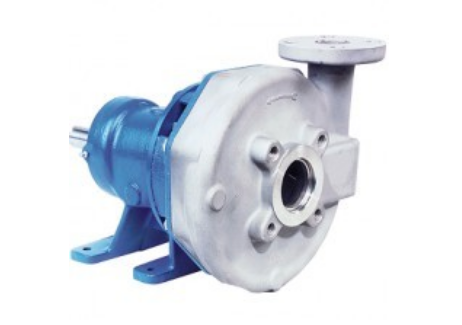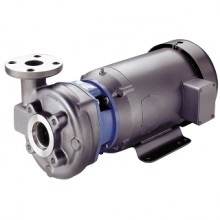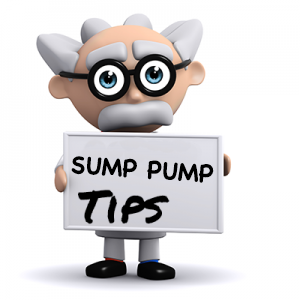-
Goulds 3757 Series Centrifugal Pumps Buyers Guide & Review
January 18, 2019The Goulds 3757 Centrifugal Pump Series is commonly used for pure water transfer, chemical transfer or food and beverage processing. The close coupled, compact design of the 3757 Series saves space and simplifies installation. This series is constructed of precision investment cast 316 stainless steel liquid end components for corrosion resistance and added strength. The frame mounted design also allows for flexibility of installation driver arrangements. An enclosed impeller means maximum efficiency and service life with no need for clearance adjustment. The back pull out design simplifies maintenance by allowing the casing to remain in the piping during disassembly. Vertical discharges come standard though this series is field modifiable to four other standard positions. Shafts and sleeves are constructed of high strength steel. They are protected from pumpage by an O-ring seal. Mechanical seals are standard Flowserve Type 31 seals with carbon versus silicon-carbide faces, viton elastomers and 316 stainless steel metal components. Options are available for high temperature and mild abrasives. Drive motors are NEMA standard JM frames or T frames that are available in both single and three phase options with a variety of enclosures and voltages to match your service requirements. Please note that this Goulde 3757 Centrifugal Pump Series includes the pump end only. Motors must be purchased separately. GOULDS 3757 SERIES CENTRIFUGAL PUMPS Model Comparison Chart Model Discharge (flanged) Suction (flanged) Impeller HP (3500 RPM) GPM (3500 RPM) Max. Head (3500 RPM) 3SSFRMD0 1-1/2" 2" 4-3/4" 2.2 152 92' 3SSFRMA0 1-1/2" 2" 6" 5.8 192 150' 3SSFRMC0 1-1/2" 2" 5-1/4" 3.8 168 114' 3SSFRMB0 1-1/2" 2" 5-5/8" 4.5 183 130' 5SSFRMK0 1-1/2" 2" 5-1/2" 6.9 215 133' 5SSFRMD0 1-1/2" 2" 7-1/4" 17.1 306 238' 5SSFRMG0 1-1/2" 2" 6-1/4" 10.3 267 180' 5SSFRMA0 1-1/2" 2" 8-1/16" 25 334 294' 5SSFRMJ0 1-1/2" 2" 5-7/8" 8.6 237 153' 5SSFRMC0 1-1/2" 2" 7-1/2" 18.4 317 255' 5SSFRML0 1-1/2" 2" 5-1/4" 6.4 200 122' 5SSFRME0 1-1/2" 2" 7" 15 300 220' 4SSFRMK0 2" 3" 3-7/8" 3.4 245 57' 5SSFRMH0 1-1/2" 2" 6" 10 254 164' 5SSFRMB0 1-1/2" 2" 7-3/4" 20.9 325 273' 4SSFRMJ0 2" 3" 4-3/8" 5 280 72' 4SSFRMD0 2" 3" 5-15/16" 12.3 440 154' 4SSFRMF0 2" 3" 5-3/8" 9.1 378 120' 4SSFRMA0 2" 3" 7" 20 540 215' 4SSFRMH0 2" 3" 4-5/8" 6.2 328 88' 4SSFRMC0 2" 3" 6-3/8" 15 465 175' 4SSFRME0 2" 3" 5-1/2" 10 395 125' 4SSFRMG0 2" 3" 5-1/16" 7.5 355 103' 4SSFRMB0 2" 3" 6-3/4" 17.5 520 202' PERFORMANCE COVERAGE MATERIALS OF CONSTRUCTION DIMENSIONS AND WEIGHTS REPAIR PARTS BROCHURE Goulds 3757 Series Centrifugal Pump Brochure INSTRUCTION MANUAL Goulds 3757 Series Centrifugal Pump Instruction Manual REPAIR PARTS Goulds 3757 Series Centrifugal Pump Repair Parts Pump Products application engineers are standing by to help you find the right pump, as well as to provide price quotes, stocking availability and shipping information. Call our toll free number 1-800-429-0800 to speak to an expert today.
-
Goulds 3657 Series Centrifugal Pumps Buyers Guide & Review
November 12, 2018The Goulds centrifugal 3657 series is commonly used for pure water transfer, chemical transfer, pharmaceutical procedures or food and beverage processing. This series features materials made of superior construction. Liquid end components consist of precision investment cast 316 stainless steel for added corrosion resistance and strength. Casing for this series features an investment cast AISI type 316 stainless steel volute design for maximum efficiency. Vertical discharges come standard but are field modifiable to four standard positions. The frame mounted design allows for flexibility of installation and driver arrangements. Mechanical seals are standard Flowserve 31 seals with carbon versus silicon-carbide faces, Viton elastomers, and 316 stainless steel metal parts. Optional seals are available for high temperature and mild abrasive services. A close-coupled, compact design saves space and simplifies installation. An enclosed impeller allows for maximum efficiency and service life with no need for clearance adjustment. The back pull out design also simplifies maintenance by allowing the casing to remain in the piping during disassembly. Shafts and sleeves are comprised of high strength steel. Motors in this series are NEMA standard JM or T frames that are available in both single and three phase designs with a variety of enclosures and voltage to match your service requirements. GOULDS 3657 SERIES CENTRIFUGAL PUMPS Model Comparison Chart Model Discharge (Flanged) HP Voltage Phase GPM Max. Head 3SS2E9A0 1-1/2" 1 208-230/460 3 105 39' 3SS2ECA0 1-1/2" 1 208-230/460 3 105 39' 3SS2E1A0 1-1/2" 1 115/208-230 1 105 39' 3SS2E4A0 1-1/2" 1 115/208-230 1 105 39' 5SS2ECL0 1-1/2" 1 208-230/460 3 128 26' 3SS1HCC0 1-1/2" 3 208-230/460 3 168 114' 4SS2FCG0 2" 1-1/2 208-230/460 3 200 28' 4SS2F9G0 2" 1-1/2 208-230/460 3 200 28' 5SS2E9L0 1-1/2" 1 208-230/460 3 128 26' 5SS2FCF0 1-1/2" 1-1/2 208-230/460 3 165 47' 5SS2GCF0 1-1/2" 2 208-230/460 3 165 47' 5SS2G9F0 1-1/2" 2 208-230/460 3 165 47' 4SS2GCD0 2" 2 208-230/460 3 235 39' 5SS2E4L0 1-1/2" 1 115/208-230 1 128 26' 5SS2E1L0 1-1/2" 1 115/208-230 1 128 26' 3SS1JCA0 1-1/2" 5 208-230/460 3 192 150' 3SS1H9D0 1-1/2" 3 208-230/460 3 152 92' 5SS2HCA0 1-1/2" 3 208-230/460 3 205 72' 3SS1J9B0 1-1/2" 5 208-230/460 3 183 130' 4SS2HCA0 2" 3 208-230/460 3 275 55' 3SS1H1C0 1-1/2" 3 115/208-230 1 168 114' 4SS2F4G0 2" 1-1/2 115/208-230 1 200 28' 5SS2F1F0 1-1/2" 1-1/2 115/208-230 1 165 47' 4SS2F1G0 2" 1-1/2 115/208-230 1 200 28' 4SS2H9A0 2" 3 208-230/460 3 275 55' 4SS1HCK0 2" 3 208-230/460 3 245 57' 4SS2G9D0 2" 2 208-230/460 3 235 39' 5SS2G1F0 1-1/2" 2 115/208-230 1 164 47' 4SS2G1D0 2" 2 115/208-230 1 235 39' 5SS2G4F0 1-1/2" 2 115/208-230 1 165 47' 4SS2G4D0 2" 2 115/208-230 1 235 39' 5SS2H9A0 1-1/2" 3 208-230/460 3 205 72' 5SS1JCL0 1-1/2" 5 208-230/460 3 200 122' 4SS1JCH0 2" 5 208-230/460 3 328 88' 5SS2H1A0 1-1/2" 3 115/208-230 1 205 72' 4SS2H1A0 2" 3 115/208-230 1 275 55' 4SS2H4A0 2" 3 115/208-230 1 275 55' 4SS1H1K0 2" 3 115/208-230 1 245 57' 3SS1J1A0 1-1/2" 5 115/208-230 1 192 150' 5SS1J9L0 1-1/2" 5 208-230/460 3 200 122' 4SS1J9J0 2" 5 208-230/460 3 280 72' 5SS1KCJ0 1-1/2" 7-1/2 208-230/460 3 237 153' 5SS2J9A0 1-1/2" 5 208-230/460 3 205 72' 4SS1KCF0 2" 7-1/2 208-230/460 3 378 120' 5SS1K9K0 1-1/2" 7-1/2 208-230/460 3 215 133' 3SS1H4D0 1-1/2" 3 115/208-230 1 152 92' 4SS1J1H0 2" 5 115/208-230 1 328 88' 5SS1J1L0 1-1/2" 5 115/208-230 1 200 122' 4SS1LCD0 2" 10 208-230/460 3 440 154' 5SS1LCG0 1-1/2" 10 208-230/460 3 267 180' 4SS1K9G0 2" 7-1/2 208-230/460 3 355 103' 4SS1L9E0 2" 10 208-230/460 3 395 125' 3SS1J4B0 1-1/2" 5 115/208-230 1 183 130' 4SS1K1F0 2" 7-1/2 115/208-230 1 378 120' 5SS1K1J0 1-1/2" 7-1/2 115/208-230 1 237 153' 5SS1L9H0 1-1/2" 10 208-230/460 3 254 164' 5SS1MCE0 1-1/2" 15 208-230/460 3 300 220' 4SS1MCB0 2" 15 208-230/460 3 520 202' 4SS1L1D0 2" 10 115/208-230 1 440 154' 5SS1L1G0 1-1/2" 10 115/208-230 1 267 180' 4SS1NCA0 2" 20 208-230/460 3 540 215' 4SS1J4J0 2" 5 115/208-230 1 280 72' 4SS1M9C0 2" 15 208-230/460 3 465 175' 5SS1M9E0 1-1/2" 15 208-230/460 3 300 220' 5SS1NCB0 1-1/2" 20 208-230/460 3 325 273' 4SS1N9A0 2" 20 208-230/460 3 540 215' 5SS1N9C0 1-1/2" 20 208-230/460 3 317 255' 5SS1PCA0 1-1/2" 25 208-230/460 3 334 294' PERFORMANCE CURVES MATERIALS OF CONSTRUCTION MOTOR DIMENSIONS REPAIR PARTS TECHNICAL BROCHURE Gouls 3657 Series Centrifugal Pump Technical Brochure INSTRUCTION MANUAL Gouls 3657 Series Centrifugal Pump Instruction Manual REPAIR PARTS Gouls 3657 Series Centrifugal Pump Repair Parts Pump Products applications engineers are standing by to help you find the right pump, as well as to provide price quotes, availability and shipping information. Call our toll free number 1-800-429-0800.
-
3 Signs You Need a New Sewage Pump
October 11, 2018Below is a list of a few things you never want to see break down: The 87’ Volvo you’ve owned since college breaking down during a long road trip. Your 87 year old grandma breaking it down during the bridge of a popular hip-hop song. (Most costly of all) Your sewage pump breaking down after your extended family comes over for a 4 course Thanksgiving dinner. Sewage Pumps are used to transport waste and solids up to 2 inches in diameter to a public sewer or septic tank. Though sewage pumps typically have a service life that can last 10 or even 30 years depending on circumstances and variables, they are not immune to certain malfunctions without regular maintenance. Below are a few signs and indications that you may need to call your local plumber or look for a replacement sewage pump. Smells Perhaps the most obvious (and arguably worst) sign your sewage pump needs replacing would be the-why-does-my-basement-smell-like-my toilet-bowl fragrance suddenly emanating from your basement. This could be an indication that your pump is not emptying the pit or basin after it turns on. Smells could also mean you have a pipe leak in your system. If you or your local plumber can’t find a pipe leak, this could mean your sewage pump is faulty and may need replacing. Continuously Running If the pump is running constantly this could be an issue with your float switch. Float switches basically tell your pump when to turn on and when to turn off. When the water within the pit or basin reaches a certain height, it moves the float switch which in turn activates the pump. If the float switch is tethered, make sure the switch can properly hang straight down and is not encumbered or stuck. Constantly running can lead to a pump burning itself out or significantly shortening its service life. Fluid not being pumped If your pump is running but the basin is not emptying of wastewater, it could mean that your pump is clogged or not drawing enough power to create the suction necessary to pump. This could also be a symptom of your pump being overheated and shutting off from thermal overload. Be sure to monitor your pump and to minimize any toilet flushing to ensure that no wastewater floods over your basin or pit. Please note, that if there are a few inches of water in the bottom of the pit at any given time, this is normal and nothing to worry over. Remember that taking care of your sewage pump will mean your sewage pump taking care of you. Pump repairs can be costly and it may be more cost effective just to purchase a replacement. Fret not because if you’re reading this, you’re in the right place. PumpProducts.com carries a wide variety of sewage pumps from the most reliable brands in the industry like Goulds, Zoeller, and Myers among others. We also offer some of the lowest prices on the web. Call our application engineers and they can help size you out the right pump for your application. This means next Thanksgiving you can eat comfortably, knowing your reliable sewage pump is doing the dirty work so you don’t have to. Pump Products application engineers are standing by to help you find the right pump, as well as to provide price quotes, stocking availability and shipping information. Call our toll free number 1-800-429-0800 to speak to an expert today.
-
3 Common Grinder Pump Problems
October 11, 2018Grinder Pumps are not just for making cool videos of cutting up rubber chickens. Grinder pumps are used in applications that require large solids to be sheared into a fine slurry, which is then pumped into a sewage system. Think sort of like a blender, but not the kind made for smoothies. Grinding solids down also allows grinder pumps to be suitable for applications which require higher heads. Grinders however, like all pumps, are not immune to their environment and require care and maintenance (if Inspector Pumphead has one thing he wants people to know, it’s that pumps need a little TLC every now and then too). Problems with your grinder pump can lead to other serious problems like sewage backup so making sure your grinder pump is in tip-top shape will save you headaches and repair costs down the road. Below are some common issues grinder pump owners can experience and some solutions. Clogs There are some things that shouldn’t be flushed down a toilet or poured down a drain. Materials such as kitty litter, paint, disposable napkins, and oil should all stay far away from your pipes. Substances such as these can build-up and become debris which in turn will restrict the flow of a grinder pump. Clogs can lead to more serious problems, like sewage being leaked onto your lawn (no one wants to mow that grass). A common fix to prevent blockages is to wash the pump periodically using a standard garden hose. Clotting If your pump is making a strange, whirring noise when it’s activated, this could be a sign of clotting. Clotting occurs after larger pieces of debris get caught and stick to the inner workings of the pump. This debris accumulates over time and can expand within the pump. Clotting can lead to a pump operating more slowly or even turning on more frequently. If your grinder is suffering from clotting, the best option is to call your local plumber and have the pump cleaned out. Freezing If you live in warmer climates, grinders can be buried a few feet underground without a second thought. However if you live in a colder climate, it is important to know what your frost line is. Frost line (sometimes referred to as frost level or frost depth) is the maximum depth below the soil that does not freeze in the winter. Wastewater traveling through a grinder that is not buried deep enough can freeze and seriously damage the inner workings of the pump. It is also important to keep in mind the depth at which your pipes are buried when it comes to frost line as frozen pipes can be just as much of a headache. If your pump is continually giving you issues or needs constant repairs, the best solution is to visit or call PumpProducts.com. Luckily PumpProducts.com carries grinder pumps for a variety of applications from the most trusted brands in the industry. Give our experts a call and they can help you select a brand-spankin-new pump that will work in your system so your pump can get to grinding wastewater instead of grinding your gears (bad joke alert, I know, but I couldn’t help myself). Pump Products application engineers are standing by to help you find the right pump, as well as to provide price quotes, stocking availability and shipping information. Call our toll free number 1-800-429-0800 to speak to an expert today.
-
5 Signs it’s Time to Get a New Sump Pump
June 12, 2018Nobody likes a flooded basement. Sump pumps sit in your basement or crawl space and drain water in order to prevent flooding. Keeping your basement dry however, can prove to be taxing on a pump over time. Below are five reasons it might be time to invest in a new sump pump. Making weird noises If your pump is particularly noisy or making irregular sounds, it could mean a part is either damaged or broken. Sump pumps are relatively quiet when they are running properly, so unusual noises can be a sign it’s time for a new pump. A noisy pump can also be the result of an issue with the pump’s motor, so be sure to keep an ear open. Not so-good vibrations If your whole pump is vibrating, it could mean a damaged impeller. The impeller is the mechanism that draws water into the pump. Unfortunately, sometimes debris can get sucked into the pump as well, which could bend the impeller. Impellers are balanced specifically to reduce, wear on the shaft of the pump. They can prove difficult to properly replace so you may either want to call a plumber or replace the entire unit. Infrequent pump usage Limited use of a sump may reduce its shelf life. Be sure to test and clean your pump regularly between heavy rain falls in order to make sure all of the pump’s components are in proper working order. If your pump is running why don't you go catch it Alternatively, if your pump is constantly running, it could also shorten the pump’s service life. The most likely culprit of a constantly running pump is likely a faulty switch. The float switch is responsible for turning the pump on and off. Sometimes during operation, sumps can shift around in their basins and the float can become inhibited, leaving the pump unable to turn off. Constant operation can lead to a pump burning itself out. Your pump may also not be able to handle the water load it's supposed to, which may lead to constant running as well. Father Time Even sump pumps aren’t immune to old age. The service life of a pump can vary due to several variables though the general life expectancy. However, for most sump pumps, it is around ten years. Regardless of maintenance, testing, and cleaning, pumps experience wear-and-tear, and eventually they will need to be replaced. If your sump fails, don’t fret, because luckily PumpProducts.com carries a wide variety of the most reliable and trustworthy sump pumps on the market. PumpProducts.com sales specialists are standing by to help you find the right pump or part, as well as to provide price quotes, stocking availability, and shipping information. Call our toll free number 1-800-429-0800 to speak to an expert today.
-
Inspector Pumphead’s FAQ: Well Pump Edition
May 23, 2017Welcome to Inspector Pumphead’s Frequently Asked Questions! I will be answering some of the most common questions we get on a specific topic. Some of this information may also be available elsewhere, but this feature will serve as a convenient one-stop source. In this edition, I'll talk about well pumps. Well Pump FAQ 1. Why are there two different types of well pumps listed What’s the difference between ‘jet’ and ‘submersible’ Jet well pumps are surface pumps configured above the well system, while a jet assembly system (twin pipe or Packer depending on the application) is inserted into the well shaft. The main components of a jet pump are a nozzle, venturi and the jet itself. The physics and mechanics of it are interesting, but we’ll focus on the basics here: these components work together to create a vacuum above the water, which allows atmospheric pressure underneath to push the water upwards. Jet pumps can be either horizontally or vertically configured and are much the same size and shape as other pumps. Submersible well pumps are actually installed and submerged under water at the base of the well. Whereas jet pumps use suction to pull water, submersible pumps create pressure to push the water in an upward direction. Submersible well pumps are cylindrical and “thin” in diameter so as to easily fit down a well shaft. They are often tall as well since submersible well pumps usually contain multiple stages stacked on top of each other. A stage is simply a compartment with an impeller, diffuser and upthrust washer that increases the pressure as water moves up through each stage. The more stages, the higher the head. 2. So which one is better As is always the case when it comes to pumps, the answer is “it depends on your system and application.” Submersible pumps are more efficient, especially in deeper wells. The farther the pump is away from the water table, the less effective it will be. Since submersible well pumps are closer to the source, they are more reliable. The downside to a submersible pump is that it must be pulled out for maintenance, repair or replacement. Being submerged also exposes the pump to contaminants such as sand. 3. What constitutes a ‘deep well’ or ‘shallow well’ The depth of the well refers specifically to the depth of the water table, which is the top of the reservoir. A water table 25 ft. or fewer underground, while any water table deeper than 25 ft. is considered a deep well. 4. What is a convertible jet pump A convertible jet pump is a pump that can be configured for either shallow well or deep well applications with the proper fittings. Convertible jet pumps are often built as deep well jet pumps and include a bolt on shallow well adapter. Deep well fittings, such as the jet assembly (twin pipe or Packer) are usually purchased separately. 5. Why would I need a convertible pump Shouldn’t I just get either a deep well or shallow well pump Usually you’d be able to stick with either one or the other type of jet well pump. In some areas, however, water tables may fluctuate due to the climate, unique elevation, topography changes or other factors. A convertible jet well pump ensures that you will be prepared and will continue to receive well water in such a case. Pump Products application engineers are standing by to help you find the right pump, as well as to provide price quotes, availability and shipping information. Call our toll free number 1-800-429-0800.










